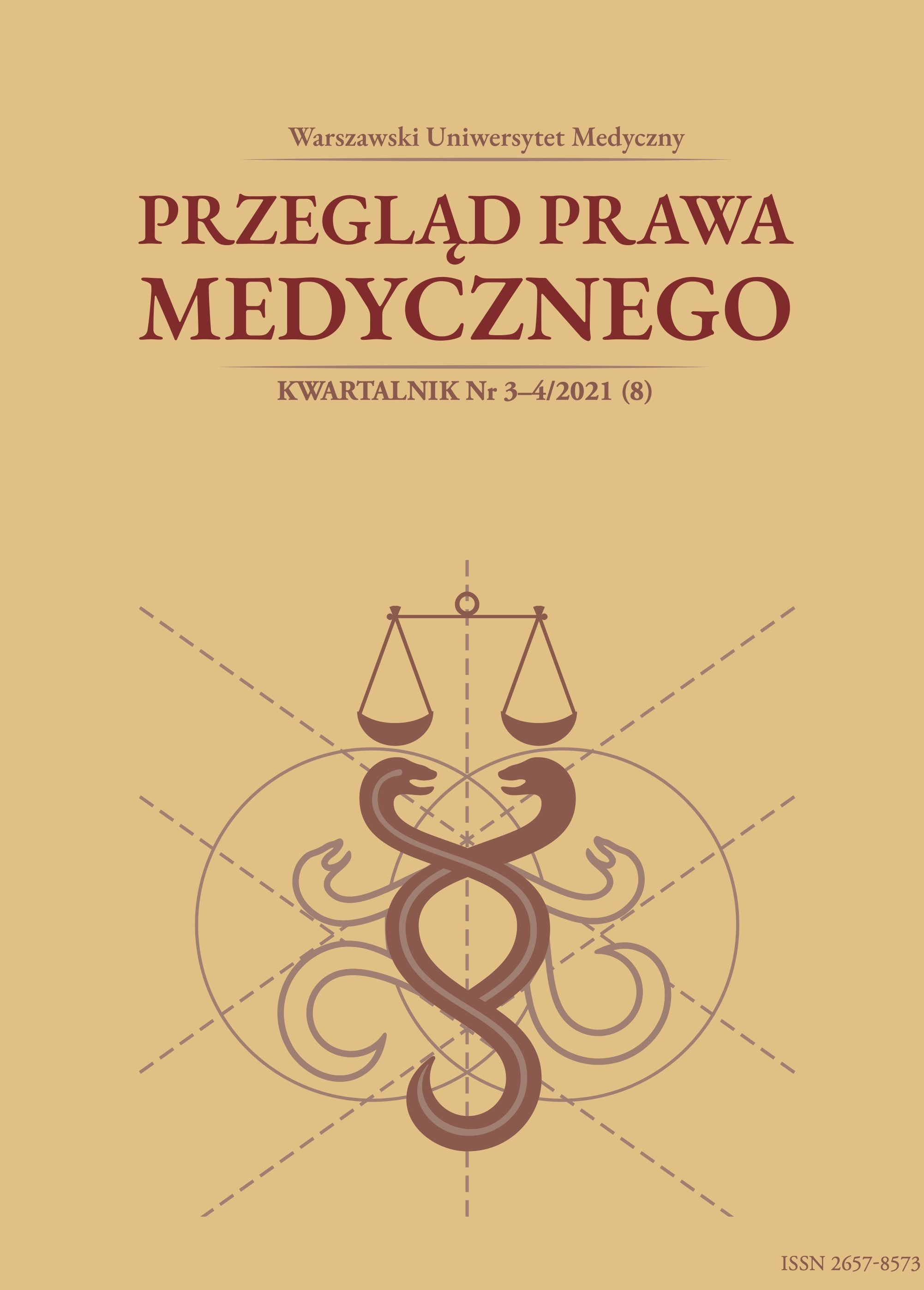Abstract
The article is a case study rather than a traditional commentary (glossa). Its subject is a disciplinary case, that was heard by a first instance medical court in Warsaw, attached to the Mazowiecka Okręgowa Izba Lekarska (Mazovian Regional Chamber of Physicians). The medical courts are not „real” courts as provided by Chapter VIII of the Polish constitution of 1997. Notwithstanding they are established by statutory law (Ustawa o izbach lekarskich) and they use both substantive and procedural rules that are provided by law and are clearly analogous to criminal responsibility.
The starting point for the case was an medical intervention, undertaken (in 2009) for purely cosmetic purposes – „skin rejuvenation” or, more precisely, a fractional photothermolysis, by use of a specially designed laser device (fractional laser). It resulted in severe complications and, finally, in grave and irremovable scarring on the patient's cleavage. Facts of the case are thorougly presented, as well as scientific and practical background of the use of high-energy lasers in cosmetic surgery, including history of such practices since the late eighties of the 20th century. Then, three important legal questions are discussed:
(1.) What is generally the status of purely cosmetic medical interventions under today's Polish law? – the answer appears vague, as this class of interventions is under some conditions perceived permissible both by the legal doctrine and the courts, but such a conclusion doesn't come from any actual statutory provisions (and Polish legal system is, as a rule, statutory).
(2.) The article fully refers the court's detailed reasoning on the causal relationship between initial medical intervention and final harm, suffered by the patient. Within the scope of causation the case can be recognized as paradigmatic. The events arranged a clear „causal chain”, the chain's links were well identifiable and relatively easy to be proven, without referring to presumptions, suppositions, statistical typicality and similar instruments of arguing. The court didn't appeal as well to „but-for” (conditio sine qua non) reasoning and using of the „but-for” causation test (in this case it would be obviously useless, redundant and idle). The article contains also some considerations on the of so-called obiektywne przypisanie skutku (objective attribution of an effect, i.e. an equivalent of German objektive Zurechnung doctrine) and on use of such a test in the discussed case (this part is only hypothetical).
(3.) Finally, the opposition „careful”/„careless” as a premise of responsibility is discussed. A human action is usually interpreted as careless if it is in discordance with some technical safety rules. In the case discussed the surgeon carried out the full scale intervention using arbitrary settings of the laser and omitted the test irradiation of a small area of the patient's skin. It could be put into doubt if the tests were really an obligatory rule, but the medical court decided it positively: however such a rule was not explicitly declared by medical manuals, it can be deduced from the the actual practice based on scientific evidence.
References
M.M. Avram, W.D. Tope, T. Yu, E. Szachowicz, J.S. Nelson, Hypertrophic Scarring of the Neck Following Ablative Fractional Carbon Dioxide Laser Resurfacing, „Lasers in Surgery and Medicine” 2009 Mar, 41(3)
https://www.ncbi.nlm.nih.gov/pmc/articles/PMC2747732/ [28.08.2021]
M. Bielski, Obiektywna przypisywalność skutku w prawie karnym, Kraków 2009, niepubl. praca doktorska
S.R. Cohen, A. Goodacre, S. Lim, J. Johnston, C. Henssler , B. Jeffers, A. Saad, T. Leong, Clinical Outcomes and Complications Associated with Fractional Lasers: A Review of 730 Patients, „Aesthetic Plastic Surgery”, 2017 nr 41.
T. Dybowski, Adekwatny czy konieczny związek przyczynowy, „Palestra” nr 6 i 7 z 1961 r.
L. El Halal Schuh, A. Haddad, M. Francischelli, I. Crivelatti, Impact of fractional CO2 laser treatment on hypertrophic scars and keloids: a systematic review, „Revista Brasileira de Cirurgia Plástica”, nr 34(1) z 2019 r.
Z. Gąszczyk-Ożarowski, Związek przyczynowy w wybranych rodzajach opinii sądowo-lekarskich, „Archiwum medycyny sądowej i kryminologii” 2015; vol. 65 (supl. 1/2015)
J. Giezek, Naruszenie obowiązku ostrożności jako przesłanka urzeczywistnienia znamion przestępstwa nieumyślnego, PiP nr 1 z 1992 r.
J. Giezek, Przyczynowość oraz przypisanie skutku w prawie karnym, Wrocław 1994
M.H. Gold, Update on Fractional Laser Technology, „The Journal of Clinical and Aesthetic Dermatology”, 2010 Jan; 3(1); https://www.ncbi.nlm.nih.gov/pmc/articles/PMC2921736 [28.08.2021]
E.M. Graber, E.L. Tanzi, T.S. Alster, Side effects and complications of fractional laser photothermolysis: experience with 961 treatments, „Dermatological Surgery”, 2008 Mar, nr 34(3); https://pubmed.ncbi.nlm.nih.gov/18190541/ [20.08.2021]
P. Konieczniak, Czyn jako podstawa odpowiedzialności w prawie karnym, Kraków 2002
R. Kubiak, Odpowiedzialność karna za wykonywanie zabiegów kosmetycznych. Zagadnienia teorii i praktyki, Kraków 2012
W. L. Mang, F. Neidel, M.S. Mackowski, A. Becker, J-T. Schantz, U. Then-Schlagau, Manual of Aesthetic Surgery 2nd ed., Springer 2010
D. Manstein, G.S. Herron, R.K. Sink, H. Tanner, R.R. Anderson, Fractional photothermolysis: a new concept for cutaneous remodeling using microscopic patterns of thermal injury, „Lasers in Surgery and Medicine”, 2004 nr 34 (5)
R. Rejmaniak, Wymóg formy pisemnej zgody pacjenta w świetle art. 192 k.k., „Prawo i Medycyna” nr 1-2 z 2013 r.
J. Sawicki, Błąd sztuki przy zabiegu leczniczym w prawie karnym, doktrynie i orzecznictwie, Warszawa 1965
T. Sroka, Odpowiedzialność karna za niewłaściwe leczenie. Problematyka obiektywnego przypisania skutku, Warszawa 2013
System prawa medycznego t. II Regulacja prawna czynności medycznych, red. M Boratyńska, P. Konieczniak, Warszawa 2019 (Wolters Kluwer)
System prawa medycznego t. III Odpowiedzialność prawna w związku z czynnościami medycznymi, red. T. Dukiet-Nagórska, A. Liszewska, Warszawa 2021 (Wolters Kluwer)
A. Zoll, Odpowiedzialność karna lekarza za niepowodzenie w leczeniu, Warszawa 1988

This work is licensed under a Creative Commons Attribution 4.0 International License.
Copyright (c) 2022 Przemysław Konieczniak

